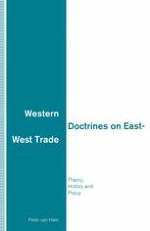1992 | OriginalPaper | Chapter
Economic Security and the Cold War: Selective Peace and Prosperity
Author : Peter van Ham
Published in: Western Doctrines on East-West Trade
Publisher: Palgrave Macmillan UK
Included in: Professional Book Archive
Activate our intelligent search to find suitable subject content or patents.
Select sections of text to find matching patents with Artificial Intelligence. powered by
Select sections of text to find additional relevant content using AI-assisted search. powered by
In Chapter 4 we already touched upon the period of concord between the USSR and several Western democracies, which proved to be not very enduring. When World War II eventually came to a close, the cement of anti-fascism had evidently dissolved. The following quest for dominance in Central Europe, and general incompatibility of both interests and ideological make-up, stood at the cradle of what turned out to be a Cold War. This is not the place to give an overview of the major explanations of why and how the Cold War started and evolved over time.1 What we will do here is present an analysis of U.S. postwar economic strategy toward the Soviet Union, which was similar to Western policy directly after 1917, namely containing the westward flow of Communism in the direction of Western Europe. In earlier chapters we have seen that during the war, sincere expectations of U.S.-Soviet cooperation were cherished. We will see that this change from a more positive to a more negative Western image of the Soviet Union occurred during a relatively short period of time, and that the ‘containment’ approach formed a political watershed in postwar U.S.-Soviet relations.
